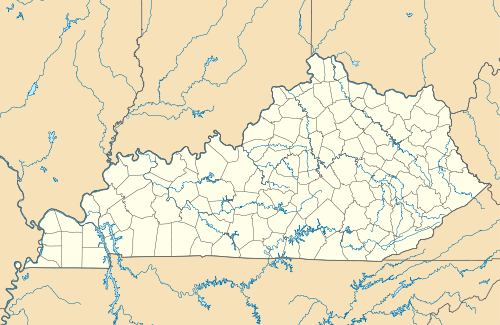Fort Hill (Frankfort, Kentucky)
|
Archeological Site 15 FR 368 | |
  | |
| Nearest city | Frankfort, Kentucky |
|---|---|
| Area | 4 acres (1.6 ha) |
| Built | 1862 |
| NRHP reference # | 85002370[1] |
| Added to NRHP | September 12, 1985 |
Fort Hill is a hill overlooking downtown Frankfort, Kentucky, where military fortifications were built by the 103rd Ohio Infantry[2] during the American Civil War to protect the city and its pro-Union state government. In September of 1862 the Confederate States of America took control of Frankfort, becoming the only Union capital to be conquered during the Civil War.[3]
Although the Commonwealth of Kentucky did not secede from the Union, an attempt was made to set up a Confederate government at Bowling Green in western Kentucky. A Bluegrass Kentuckian, George W. Johnson of Scott County, was elected first Confederate Governor of Kentucky.[4] He was killed at the Battle of Shiloh. After his death, Richard Hawes of Bourbon County was inaugurated the next Confederate governor at the Old Capitol Building in Frankfort, on October 4, 1862.
While the inauguration ceremonies were still underway, Federal forces appeared on the hill to the west of Frankfort and caused Governor Hawes and the Confederates to speedily conclude the ceremony and withdraw from Frankfort toward Versailles in Woodford County. When the Union forces advanced on Frankfort from Louisville on Oct. 4, 1862, the Southerners retreated south. Four days later, the Battle of Perryville was fought in Boyle County. Unable to capitalize on their battlefield success at Perryville, the Confederates left the state via the Cumberland Gap.[5]
March 1863 two earthen forts, Fort Boone(not to be confused with Fort Boone) and the larger New Redoubt, were constructed by army engineers, 103rd Ohio Infantry and civilian labor. Written by Lyman Beecher Hannaford, 103rd OVI, [6]March 26, 1863, "we have now moved our encampment up on the hill in the rear of the fort. The regiment moved yesterday morn early" [7]. In 1864, local militia in Fort Boone successfully repulsed an attack on Frankfort by raiders from the Confederate cavalry under John Hunt Morgan.
The Fort Hill site is now a park and historic site, with a beautiful view of the city and the Kentucky River Valley. The 124-acre (0.50 km2) heavily forested park preserves the remains of the two Civil War earthwork forts, and is also used for Civil War reenactments. A circa 1810 log house, known as the "Sullivan House," has also been moved to the site. It houses exhibits about Fort Hill and the history of Kentucky's log buildings. The Sullivan House also serves as a site for living history activities.[8]
Notes
- ↑ National Park Service (2010-07-09). "National Register Information System". National Register of Historic Places. National Park Service.
- ↑ Civil War in Frankfort: Fort Hill by State Journal Staff Report December 10, 2011
- ↑ https://www.state-journal.com/2011/06/18/civil-war-frankfort-a-very-different-place/
- ↑ http://www.visitlex.com/quick/civilwar.html
- ↑ http://explorekyhistory.ky.gov/items/show/497
- ↑ Original letter located at the 103rd OVI Museum http://www.103ovi.com/
- ↑ https://lymanbhannaford.wordpress.com/26-march-1863/
- ↑ "Leslie Morris Park on Fort Hill". Frankfort Parks and Rec Department. Retrieved June 15, 2014.
References
Coordinates: 38°12′17″N 84°52′14″W / 38.20467°N 84.87067°W